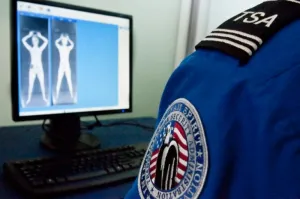By 2014, the Transportation Security Administration plans to deploy body scanners at almost every airport security lane in America. The TSA uses two types of scanners: the millimeter wave and the X-ray backscatter. In our ongoing investigation, we’ve exposed details about each scanner’s health risks, false alarm rates and effectiveness. But to break it down further, here’s a side-by-side comparison of both types. Passengers can decline either scanner and get a pat-down instead. | Related story »
| Millimeter Wave | X-Ray (Backscatter) | |
|---|---|---|
| What does it look like? |  |
 |
| How does it work? | A millimeter wave machine beams radio frequency waves over the surface of the body using two rotating antennas. The energy reflected back from the body is analyzed for anomalies. Because of controversy over a “virtual strip search,” TSA swapped the image with a generic unisex outline that resembles the cartoon character Gumby. | A backscatter machine directs a low intensity X-ray beam over the surface of the body. Instead of transmitting rays through the body, as medical X-ray machines do, these backscatter rays are reflected back to detectors, which convert them into a 2D image that resembles a chalky sketch. |
| What energy is used? | Low-powered millimeter waves, which are not a form of ionizing radiation. (Ionizing radiation is powerful enough to strip electrons off atoms and damage DNA, potentially leading to cancer.) | Low levels of ionizing radiation. According to the TSA, each scan gives off less than 10 microREM of radiation. This is equivalent to the radiation a passenger would receive flying for two to three minutes at typical cruising altitude. |
| What does a security officer see? |  |
 |
| What’s the process like? | After you walk into the phone booth-like scanner, a security officer inspects the image displayed on a monitor attached to the machine. If the machine detects a threat, a yellow square appears on the suspect part of the body. If not, a large OK sign pops up. | After you walk through the rectangular paneled scanner, a security officer sitting in another location looks at the image on a computer. If she spots an irregularity, she notifies the local officer, who then inspects the passenger further. At the end of the process, the image is deleted. |
| What’s the false alarm rate? More on false alarms |
23-54 percent, according to tests at airports in Italy and Germany, as well as initial tests in the U.S. | 5 percent, according to a British study. |
| What countries use it in airports? | The Netherlands, Canada, the U.K., Italy, Australia, and the U.S. | The U.K. (not for routine screening but only for passengers who raise suspicion or set off the metal detector), Nigeria, and the U.S. The European Union recently prohibited X-ray body scanners. |
| What U.S. airports use it? Check out this searchable database for a more complete list |
ATL, BWI, DEN, DCA, DFW, EWR, IAH, IND, MSP, SFO | BOS, JFK, LAX, MEM, ORD, SAN, SAT, SEA, STL, SJU |
| What are known health/safety issues? | No known health risks. | Even though the radiation X-ray scanners emit is miniscule (equivalent to two to three minutes of flying at altitude), two peer-reviewed studies estimated that six or 100 U.S. airline passengers each year could develop cancer from the machines. |
| How many exist? | About 300 millimeter-wave scanners are currently in U.S. airports. The TSA plans to install 250 more by next spring. | About 250 X-ray scanners are currently in U.S. airports. |
| How much does it cost? | The U.S. uses L-3 Communications’ ProVision scanner, which costs $170,000 to $180,000 a piece. | The U.S. uses Rapiscan’s Secure 1000 scanner, which costs $170,000 to $180,000 a piece. |
Images courtesy of TSA.gov.











